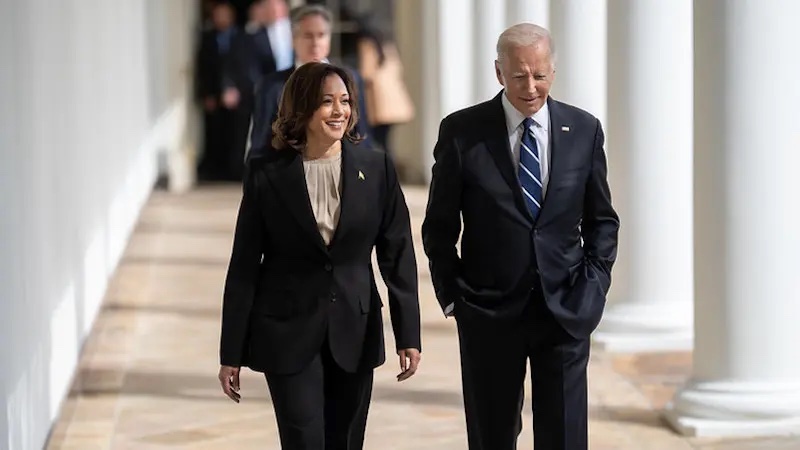What’s Behind Biden And Harris’s Supreme Court ‘Reform’ Plan? – OpEd

As he exits stage left, PresidentJoe Bidenhas proposed a three-point plan to rein in the Supreme Court, the branch of government that the Left increasingly considers a “threat to democracy.”
The proposal calls for limiting the terms ofSupreme Courtjustices to 18 years, imposing an “enforceable” code of ethics on the court, and amending the Constitution to overturnTrump v. United States, the recent court ruling clarifying the extent to whichpresidentscan claim immunity from prosecution for acts taken while in office.
Like everything else progressives embrace, the proposal was quickly endorsed by Vice President Kamala Harris, who Democratic Party poohbahs have anointed to succeed Biden as the party’s presidential nominee.
Implementing the first proposal—18-year term limits—would require a constitutional amendment. Article III grants lifetime tenures toallfederal judges, a provision intended to insulate the judiciary from shifts in the political winds and to reinforce the Constitution’s separation of powers. Only three sitting justices currently have served for at least 18 years: Chief Justice John Roberts and Associate Justices Samuel Alito and Clarence Thomas).Forty-five justices have served longer than that, including progressive icons Ruth Bader Ginsburg, who served on the court from 1993 to 2020, and William O. Douglas, who served nearly 37 years—a record.
The Biden-Harris proposal channels their left-leaning political base’s anger over Supreme Court rulings rejecting, on constitutional grounds, elements of their progressive policy agenda.
That’s also what drove President Franklin Roosevelt’s Supreme Court “reform” effort in 1937. FDR’s impetus was the court’s failure, usually on 5-4 votes, to support some of the ornaments of the First New Deal, such as the Agricultural Adjustment Act and National Industrial Recovery Act.
Arguing that the “nine old men” then serving on the judicial system’s highest tribunal were overworked and too elderly to do their jobs, Roosevelt asked Congress forauthority to nominate up to six new justices, adding a seat for every incumbent justice older than 70 years who did not retire within six months. FDR’s reform could have been adopted because the Constitution does not say anything about the Supreme Court’s size. It’s been as few as six justices (at the Founding) and as many as 10 (under President Abraham Lincoln). Today’s nine-member court dates from 1869.
Known ever since as FDR’s court-packing scheme, the proposal miscarried dramatically because of presidential hubris. Roosevelt had been reelected to the White House in 1936 by what was then history’s largest Electoral College majority. So, he made the mistake of proceeding without consulting congressional leaders, including those from his own party. His plan died.
The trigger for Biden and Harris was the court’s 2022 ruling inDobbs v. Jackson Women’s Health Organization, which reversedRoe v. Wade(1973) and returned decisions about abortion policies to the states. A series of other decisions, often by 6–3 majorities, curbing the administrative state’s discretionary powers in two cases upending 1984’sChevrondoctrine, rejecting the administration’s retread of the Obama-era Clean Power Plan, and strengtheningSecond Amendmentrights inNew York State Rifle & Pistol Association v. Bruen, further angered the Left.
Leaving aside the high hurdles to amending the Constitution and important questions about what external enforcer of judicial ethics Biden and Harris contemplate, it’s puzzling why they didn’t propose increasing the number of justices to assemble a more compliant majority.
In a sense, FDR’s threat to pack the court worked because in its wake, the 5-4 majorities holding New Deal legislation unconstitutional flipped into 5-4 majorities upholding the constitutionality of legislation enacted during the Second New Deal. This included the Social Security Act, another Agricultural Adjustment Act, and legislation creating the Tennessee Valley Authority.
Because the Supreme Court’s deliberations are held in strict confidence—no leaks of opinions then!—we don’t know (and likely never will) what prompted Justice Owen Roberts to withdraw his anti-New Deal votes, the famous“switch in time that saved nine.”
Maybe that’s what Biden and Harris are up to: knowing their reform plan has no chance of being adopted, they hope that bullying the court will change some justices’ votes.
What the administration studiously ignores is that the United States is a constitutional republic that everyone in the three branches of government swears an oath to uphold. And, for better or worse, it’s the Supreme Court’s job to decide what laws are consistent with that Constitution.
- This article was also published in Washington Examiner
